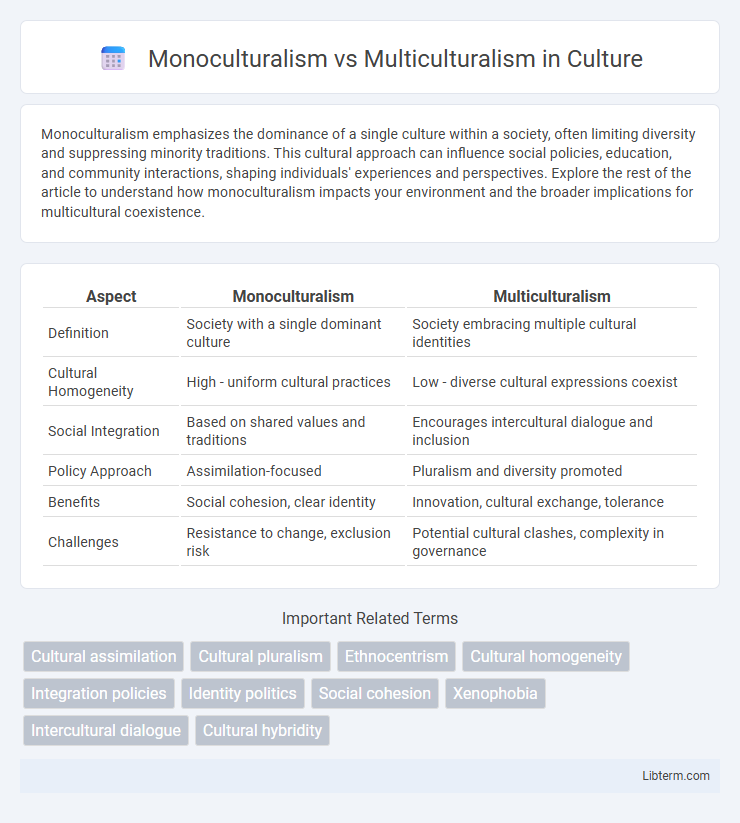Monoculturalism emphasizes the dominance of a single culture within a society, often limiting diversity and suppressing minority traditions. This cultural approach can influence social policies, education, and community interactions, shaping individuals' experiences and perspectives. Explore the rest of the article to understand how monoculturalism impacts your environment and the broader implications for multicultural coexistence.
Table of Comparison
| Aspect | Monoculturalism | Multiculturalism |
|---|---|---|
| Definition | Society with a single dominant culture | Society embracing multiple cultural identities |
| Cultural Homogeneity | High - uniform cultural practices | Low - diverse cultural expressions coexist |
| Social Integration | Based on shared values and traditions | Encourages intercultural dialogue and inclusion |
| Policy Approach | Assimilation-focused | Pluralism and diversity promoted |
| Benefits | Social cohesion, clear identity | Innovation, cultural exchange, tolerance |
| Challenges | Resistance to change, exclusion risk | Potential cultural clashes, complexity in governance |
Understanding Monoculturalism and Multiculturalism
Monoculturalism emphasizes the dominance of a single cultural identity, promoting uniformity in social norms, values, and traditions within a society. Multiculturalism recognizes and encourages the coexistence of diverse cultural groups, fostering inclusivity, cultural exchange, and mutual respect. Understanding these concepts is essential for addressing social integration, policy-making, and community cohesion in increasingly diverse populations.
Historical Roots of Monocultural Societies
Monocultural societies often trace their historical roots to homogeneous ethnic or linguistic groups that established early civilizations with shared traditions and values, reinforcing social cohesion. These societies prioritized cultural uniformity to maintain political stability and collective identity, frequently through centralized governance and exclusionary policies. Archaeological and anthropological evidence indicates that such monoculturalism was prevalent in early agrarian communities where cooperation within a single cultural framework optimized resource management and social organization.
The Rise of Multiculturalism: Global Perspectives
Multiculturalism has surged globally due to increased migration, economic globalization, and the digital age fostering cross-cultural exchanges. Countries like Canada and Australia exemplify this trend by adopting inclusive policies that celebrate cultural diversity while promoting social cohesion. This rise challenges monoculturalism by emphasizing pluralism, equity, and the recognition of minority rights on a global scale.
Cultural Identity and Social Integration
Monoculturalism emphasizes preserving a single cultural identity, often fostering social cohesion through shared traditions and values, but it may limit exposure to diverse perspectives. Multiculturalism promotes the coexistence of multiple cultural identities, enhancing social integration by encouraging inclusivity, cross-cultural dialogue, and mutual respect. Studies show that multicultural societies tend to develop stronger intercultural competencies and adaptive social networks, contributing to more dynamic community engagement.
Economic Impacts of Monocultural and Multicultural Models
Monocultural economies often benefit from streamlined decision-making and reduced internal conflict, leading to consistent business practices and potentially faster economic growth. In contrast, multicultural economies exploit diverse perspectives and skills, fostering innovation, entrepreneurship, and access to global markets, which can enhance competitiveness and adaptability. Research shows that cities with higher cultural diversity experience increased economic output and creativity, highlighting the positive correlation between multiculturalism and economic dynamism.
Educational Approaches in Monocultural vs. Multicultural Settings
Educational approaches in monocultural settings often emphasize a singular cultural perspective, promoting uniform values and knowledge aligned with the dominant culture, which can limit students' exposure to diverse worldviews. In contrast, multicultural education incorporates multiple cultural narratives, fostering critical thinking, inclusivity, and cultural competence by integrating diverse curricula, teaching strategies, and student experiences. Research shows that multicultural educational practices improve intercultural understanding and social cohesion, preparing students for globalized and heterogeneous societies.
Policy Implications: Governance and Cultural Diversity
Monoculturalism policies emphasize national unity by promoting a single dominant culture, often leading to restrictive immigration laws and limited support for minority languages, which can hinder social integration. Multiculturalism frameworks encourage governance that recognizes and accommodates cultural diversity through inclusive language policies, anti-discrimination laws, and support for cultural expression, fostering social cohesion and equal representation. Effective policy design requires balancing cultural preservation with societal inclusivity to promote stable governance and equitable cultural participation.
Challenges and Benefits of Multicultural Societies
Multicultural societies face challenges such as social integration, language barriers, and potential cultural clashes that may hinder unity. However, the benefits include enhanced creativity, economic innovation, and greater cultural awareness, which contribute to social resilience and global competitiveness. Effective policies promoting inclusion and intercultural dialogue can mitigate challenges while maximizing the strengths of diverse populations.
Social Cohesion and Conflict: Comparative Analysis
Monoculturalism often promotes social cohesion by emphasizing shared values and cultural homogeneity, reducing visible differences that can cause division. Multiculturalism fosters inclusion and respect for diverse backgrounds, which can enhance understanding but may also lead to identity-based conflicts if integration policies are weak. Comparative studies show that effective multicultural frameworks combine cultural recognition with strong social integration mechanisms to balance unity and diversity, minimizing social tensions.
Future Trends in Cultural Assimilation and Pluralism
Future trends in cultural assimilation point towards increasing multiculturalism as global migration and digital connectivity foster diverse social landscapes. The rise of pluralism promotes policies that value cultural diversity while encouraging inclusive dialogue and equity in public institutions. Shifts in educational curricula and workplace norms reflect growing recognition of multicultural competence as a critical skill for societal resilience.
Monoculturalism Infographic

 libterm.com
libterm.com